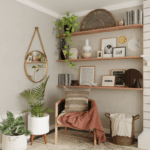Imagine walking through your home and feeling a sense of calm wash over you. There are so many benefits to decluttering your space. No more piles begging to be dealt with. No more boxes spilling over with odds and ends to get rid of (if you only knew where to take them.) No more rushed throwing of things into a closet before someone comes over to visit.
Wouldn’t it be nice to breathe easier and feel a weight lifted from your shoulders if all the clutter was gone?
If you’re feeling overwhelmed by your clutter and having trouble staying organized, you’re not alone. Whether it’s due to stress or the lack of time to organize, the truth is that clutter can increase cortisol levels (the “stress hormone”), lead to depression, decrease our ability to focus and be productive, cause sleep loss, and even negatively impact our weight.
It begs the question; are we stressed because we have clutter or do we have clutter because we are too stressed to deal with it?
Unsurprisingly women feel more stressed in a cluttered home, even when their husbands don’t. Most likely this is because the burden of housework still lies on women’s shoulders.
Conquer Clutter to Reduce Stress
The answer may be both, but there is no doubt that reducing the amount of clutter in your home can help alleviate the feeling of being overwhelmed.
There are a few theories on how best to declutter. You’ll have to find the way that works best for you.
Marie Kondo’s advice is doing it all in one go, although this doesn’t mean all in one day. She advocates for ripping off the band-aid and making the commitment to declutter and tidy as a whole life change.
In her instant classic book The Life-changing Magic of Tidying Up, she shares her best plan on which rooms and items to start with that are the most charged and challenging.
Another school of thought to start decluttering is by breaking down your house into manageable chunks. This works best for people who are looking to make gradual change, or are strapped for extra time.
Start small with a single room and give yourself an achievable goal; such as 15 minutes per day for one week. Take out anything that doesn’t belong or is no longer useful. Once you finish one room, move onto another until you eventually make it through all of them.
This part is probably the hardest, as you’ll want to move onto another room before you’ve finished the first. So, bring in some habit stacking principles here and give yourself a reward for each room you complete.

Health Benefits of Decluttering
When you take the time to declutter your home, the benefits are almost immediate. You will feel a sense of accomplishment and pride when you look around at the cleanliness that once was chaos.
You may also find that clutter had been weighing on your mind more than you realized because getting rid of it can provide a sense of mental clarity and reduce stress levels significantly. That alone is worth taking the time to declutter.
But don’t just take our word for it—science backs up these claims as well. Studies have found that clutter increases cortisol production. In addition, research has shown that clutter can increase negative feelings like guilt, shame, anxiety, depression, anger, embarrassment, frustration, or overwhelm — all things we would like to avoid.
Lastly, not surprisingly, too much clutter affects our ability to focus because we become distracted by everything else around us instead of being able to concentrate on one task at a time.

We’re wired for round
Did you know that sharp edges can increase stress levels while soft, rounded shapes promote relaxation? Our brains are wired to associate these shapes with potential danger, most likely harkening back to tool making for both safety and hunting. On the other hand, soft and rounded shapes can have the opposite effect, calming and soothing us.
Take a closer look at your surroundings and find ways to incorporate more organic shapes to promote relaxation and well-being.
It could be as simple as adding a few plants or a floral arrangement to a hard-edged table or bookshelf. Look to add rounded decor items to offset the sharp frames of pictures and furniture.

Clutter-Free Tips & Tricks
Let’s look at some strategies to help.
Address the root of the problem.
Internal roadblocks may be the reason you’re struggling to banish clutter for good. Consider your emotional attachments to objects or whether you purchase to maintain feelings of security or pleasure. Identify why you’re struggling to make a change. Again, Marie Kondo has some loving advice for us here: we often hold onto things because of obligation. Just because someone gave you something does not mean you have to hold onto it forever. Not everything is an heirloom.
Begin at the entrance.
Studies show that even entering a clutter-free environment can dramatically lower stress levels. If you incorporate elements of nature, the effects are even better.
Create a designated spot for items such as keys, mail, wallets/purses etc., so they always go back to the same place when not in use. Hooks, baskets, and cubbies are the best way to help keep these things organized and in a place where you can find them at all times.
Take small steps.
Dedicate 5-10 minutes each day to tidying up. Set aside a specific time each day and be consistent. This helps form good habits and keeps things from piling up too quickly.
Test the necessity of possessions.
To determine whether an item should go, pack a box with objects for charity. Keep it sealed and out of sight for six months. If you don’t retrieve any of it by then, donate the box unopened.
Manage digital clutter.
Computer files and phone notifications contribute to visual and mental clutter. Disable notifications and place your phone face-down to achieve focus. Clear the desktop of icons and files. Avoid using your inbox as a storage space or to-do list.
Implement a “one in/one out” rule.
Any time something new comes into your house something else must leave (donate it or throw it away).
Seek assistance.
When the mountain seems too high, enlist help from a trusted friend or professional.
Finally, remember, perfection isn’t the goal.
It’s essential that your living space caters to your life and all it’s glorious details. Objects that you use regularly, like a coffee-maker, need not be packed away to maintain a pristine counter. Keep things out that make you happy and help you on a daily basis.
And all those beautiful photos you’re comparing yourself and your space to on the internet? There’s most likely a mess behind the camera.
Sending you decluttering vibes!
Sources:
https://pubmed.ncbi.nlm.nih.gov/20053034/
https://link.springer.com/article/10.1007/s12144-017-9679-4









